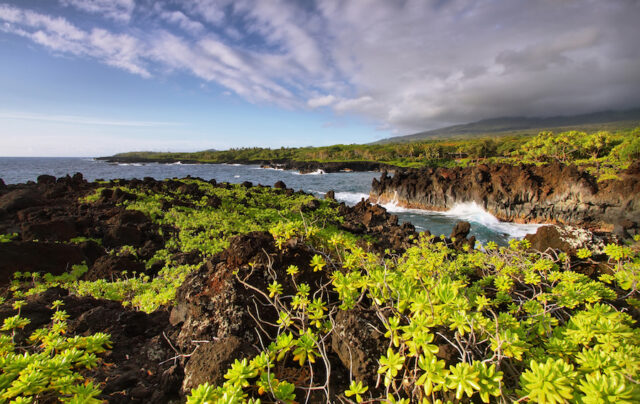Maui is home to a pair of publicly-accessible lava tubes, including one that looks as if it’s filled with the cooled-off contents of a giant chocolate fountain. The first can be found within Waianapanapa State Park, on the stunning black sand Maui beach known as Pa‘iloa. You’ll find the second one, the Hana Lava Tube less than two miles away from there. Both Maui activities and caves can be included on your trip down the Hana Highway and are some of Maui’s greatest natural wonders to see.
Cultural Significance of Maui Lava Tubes to Native Hawaiians.
Hawaii is crisscrossed by many lava tubes because our islands were created by volcanoes. These underground passageways were made by molten lava flows. When the supply of lava stopped it left behind an empty cave.
An accessible lava tube could be used as a fallout shelter by the Native Hawaiians as protection from both the natural elements of Hawaii and human enemies. Food stored in the cooler, more thermally stable lava tubes would last longer. Middens within lava tubes have contained ʻopihi shells, bones, stone tools, and other evidence of daily life.
Maui Lava Tube Trail at Waianapanapa State Park near Hana.
Waianapanapa State Park’s lava caves and tubes are unlike nearby Kaeleku Cave. For starters, one of them is partially filled with fresh water and native shrimp. Another opens up to the ocean and others serve as blowholes along the shoreline of Pailoa Bay. The shrimp-filled pools are of particular interest to many visitors because of the lore attached.
To learn more about the crustacean’s significance in Hawaiian literature, we recommend reading the story of Princess Popoalaea. According to Hawaiian legend, the princess hid in the cave from her cruel and jealous husband Chief Ka’akea. She was discovered by him and killed. In memory of her untimely death, the waters that run through the cave take on a reddish hue several times a year in honor of the princess.
Most Maui lava tubes along the park’s shoreline serve as blowholes that send columns of ocean water into the Hawaiian sky. But to find the tube you can access, turn right after descending the staircase leading to the black sand beach. There, you’ll see its entrance after a short hike. Bring a flashlight and step inside the cave and watch the ocean come rolling in.
Non-Hawaii resident visitors to the park must obtain both entrance and parking reservations in advance. Reservations are available online at www.gowaianapanapa.com.
Hana Lava Tube also known as Ka’eleku Cave.
The Hana Lava Tube is located inside Ka‘eleku Cave. A roughly quarter-mile-long portion open to the public boasts stalagmites, stalactites, a mammoth chockstone, and “Chocolate Corridor” resembling melted dessert. Visitors can expect to spend 40 minutes on a self-guided tour of the lava tube, which features interpretive signage and handrails. Flashlights are provided.
You can also break for lunch at the picnic shelter overlooking the grounds’ Red Ti Botanical Garden Maze – perfect for a sun-soaked stroll after plumbing the tube’s depths. The Hana Lava Tube is open year-round, seven days a week. The site charges fees, although children aged 5 and under are free.
Location: Just past mile marker 31 on the Hana Highway, turn left on Ulaino Road and you’ll find the visitor center close by. It is a 3-hour drive from West Maui and the Maui Kai resort at Kaanapali.
Popular Hana Highway Attractions.
A journey to Maui is likely incomplete without time spent on the lovely Road to Hana with its spectacular scenery and cliffs.
Beyond the nearby lava tubes, highlights along the waterfall-lined Hana Highway include the rainbow eucalyptus grove at Ke’anae Arboretum. These vibrant trees aren’t far from the rugged Ke‘anae Peninsula, where residents of the historic village tend taro patches, “lo‘i” and cast fishnets into the sea. The Pi’ilanihale Heiau is also found along the Hana Highway. Located within the National Tropical Botanical Garden’s Kahanu Garden, this place of worship is the largest of its kind in Polynesia, and a National Historic Landmark.
Visitors to the heiau will also find themselves amidst one of the largest native hala, or pandanus, forests in the Hawaiian Islands.
Stay at Maui Kai at Kaanapali Beach.
Now that you know where you’re going, secure a place to stay after a day of above and below ground sightseeing. Our guests enjoy all oceanfront, air-conditioned condos at Maui Kai on Ka‘anapali Beach.It is the perfect place to recoup before your next island adventure.

